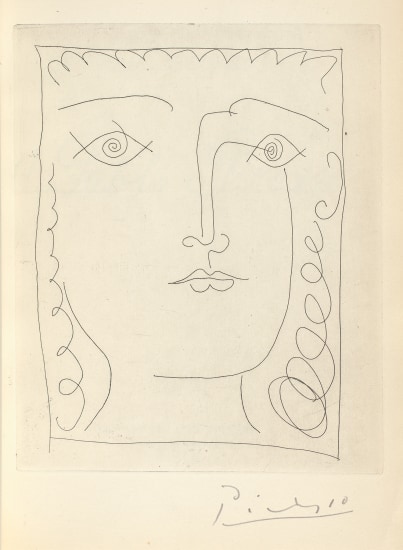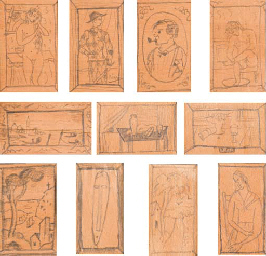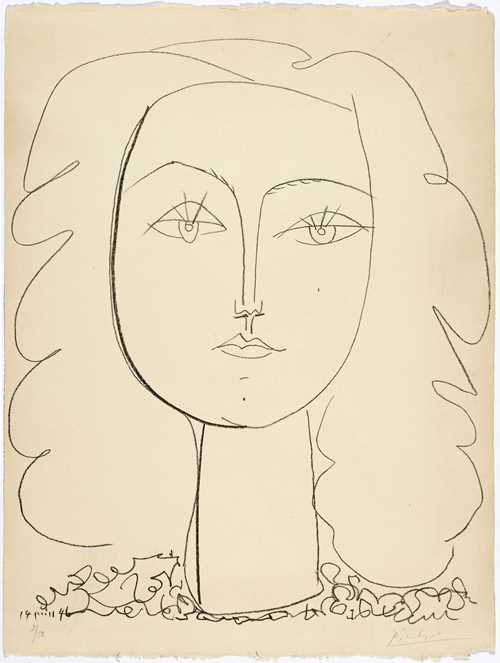Property of a Gentleman, Boston Pablo Picasso Nature morte 1937 oil on canvas 6 1/4 x 8 3/4 in. (15.9 x 22.2 cm) Signed and dated "Picasso 10.4.37." lower right.
Provenance Estate of the artist Private Collection Sotheby's, New York, Impressionist & Modern Art Day Sale, November 6, 2002, lot 322 Sir Sean Connery (acquired at the above sale) Sotheby's, New York, Impressionist & Modern Art Evening Sale, November 7, 2006, lot 36 Acquired at the above sale by the present owner Literature D.D. Duncan, Picasso's Picassos, New York, 1961, pp. 127, 223 (dated 10.8.37; illustrated, without signature) The Picasso Project: Picasso's Paintings, Watercolors, Drawings and Sculpture: Spanish Civil War 1937 - 1939, San Francisco, 1997, no. 37-177, p. 72 (dated 10.8.37; illustrated, without signature) Catalogue Essay In the context of Pablo Picasso’s long career, the year 1937 marked one of the most significant landmark moments in his artistic production. It was during this year that the artist completed arguably his most ambitious work, the canonical Guernica. With the tumultuous political unrest of the Spanish Civil War and early traces foreshadowing a looming war more widely in Europe creating tension on the continent, it is unsurprising that Picasso’s works were united by a dark palette during the following years. Nature morte, painted in 1937 marries one of Picasso’s most frequent themes, the still life, with his stylistic tendencies of this period. A domineering dark tone casts the background in shadow while the objects in the foreground are thickly outlined in an equally overpowering black. In comparison to Picasso’s earlier still-life compositions such as Nature morte au compotier (Still Life with Compote and Glass) 1914-15, the approach is far more heavy-handed. However, this confidence in applying strong strokes suggests freer movement of the paintbrush and for this reason, Nature morte appears far more spontaneous than his previous almost mathematically arranged pieces. From the outset of Picasso’s career a distinct nod towards Paul Cezanne’s oeuvre is brought to the fore. However, Cezanne’s vital role as the pivotal forerunner to Cubism is reasserted throughout the movement’s trajectory. Painted far later in his career, Nature morte illustrates this notion profoundly. Compositional, tonal and stylistic similarities are made all the more clear when one compares this work with Still Life with Fruit and a Ginger Pot, 1895. The shallow composition emphasized by the simple monochrome background in both gives rise to the heavily contoured still-life displayed before the viewer. Although Picasso approached abstraction in various capacities throughout his life, he never fully dislocated himself entirely from the figurative or relinquished the object completely. This late composition appears to return to a more complete and harmonious method of depiction as the simply laid out wine glass and fruit on a tablecloth press against the picture’s surface, all equally positioned beside each other. Even their comparable scale is accurate despite the overall flatness created by Picasso’s simplification. Compared to the highly wrought still lifes from the 1910s that were defined by their angularity, fragmentation and geometrical dissection, this composition reverts back to a simpler aesthetic and remains characteristic of Picasso’s creative endeavors. Read More Artist Bio Pablo Picasso Spanish • 1881 - 1973 Regarded as one of the most influential artists of the twentieth century, Pablo Picasso is known for his pioneering involvement in the development of Modernism and co-founding of the Cubist movement. He tirelessly investigated forms of expression with his pictorial vocabulary ranging from vivid naturalism to distorted abstraction, and his prolific output included painting, prints, drawings, ceramics and theatre sets. Endlessly curious, Picasso continually sought innovative creative avenues, experimenting with age-old printmaking processes (etching, lithography, linocut), each of which offered a distinct expressive opportunity of line, tone and mark-making. These graphic techniques, combined with Picasso's
Property of a Gentleman, Boston Pablo Picasso Nature morte 1937 oil on canvas 6 1/4 x 8 3/4 in. (15.9 x 22.2 cm) Signed and dated "Picasso 10.4.37." lower right.
Provenance Estate of the artist Private Collection Sotheby's, New York, Impressionist & Modern Art Day Sale, November 6, 2002, lot 322 Sir Sean Connery (acquired at the above sale) Sotheby's, New York, Impressionist & Modern Art Evening Sale, November 7, 2006, lot 36 Acquired at the above sale by the present owner Literature D.D. Duncan, Picasso's Picassos, New York, 1961, pp. 127, 223 (dated 10.8.37; illustrated, without signature) The Picasso Project: Picasso's Paintings, Watercolors, Drawings and Sculpture: Spanish Civil War 1937 - 1939, San Francisco, 1997, no. 37-177, p. 72 (dated 10.8.37; illustrated, without signature) Catalogue Essay In the context of Pablo Picasso’s long career, the year 1937 marked one of the most significant landmark moments in his artistic production. It was during this year that the artist completed arguably his most ambitious work, the canonical Guernica. With the tumultuous political unrest of the Spanish Civil War and early traces foreshadowing a looming war more widely in Europe creating tension on the continent, it is unsurprising that Picasso’s works were united by a dark palette during the following years. Nature morte, painted in 1937 marries one of Picasso’s most frequent themes, the still life, with his stylistic tendencies of this period. A domineering dark tone casts the background in shadow while the objects in the foreground are thickly outlined in an equally overpowering black. In comparison to Picasso’s earlier still-life compositions such as Nature morte au compotier (Still Life with Compote and Glass) 1914-15, the approach is far more heavy-handed. However, this confidence in applying strong strokes suggests freer movement of the paintbrush and for this reason, Nature morte appears far more spontaneous than his previous almost mathematically arranged pieces. From the outset of Picasso’s career a distinct nod towards Paul Cezanne’s oeuvre is brought to the fore. However, Cezanne’s vital role as the pivotal forerunner to Cubism is reasserted throughout the movement’s trajectory. Painted far later in his career, Nature morte illustrates this notion profoundly. Compositional, tonal and stylistic similarities are made all the more clear when one compares this work with Still Life with Fruit and a Ginger Pot, 1895. The shallow composition emphasized by the simple monochrome background in both gives rise to the heavily contoured still-life displayed before the viewer. Although Picasso approached abstraction in various capacities throughout his life, he never fully dislocated himself entirely from the figurative or relinquished the object completely. This late composition appears to return to a more complete and harmonious method of depiction as the simply laid out wine glass and fruit on a tablecloth press against the picture’s surface, all equally positioned beside each other. Even their comparable scale is accurate despite the overall flatness created by Picasso’s simplification. Compared to the highly wrought still lifes from the 1910s that were defined by their angularity, fragmentation and geometrical dissection, this composition reverts back to a simpler aesthetic and remains characteristic of Picasso’s creative endeavors. Read More Artist Bio Pablo Picasso Spanish • 1881 - 1973 Regarded as one of the most influential artists of the twentieth century, Pablo Picasso is known for his pioneering involvement in the development of Modernism and co-founding of the Cubist movement. He tirelessly investigated forms of expression with his pictorial vocabulary ranging from vivid naturalism to distorted abstraction, and his prolific output included painting, prints, drawings, ceramics and theatre sets. Endlessly curious, Picasso continually sought innovative creative avenues, experimenting with age-old printmaking processes (etching, lithography, linocut), each of which offered a distinct expressive opportunity of line, tone and mark-making. These graphic techniques, combined with Picasso's


.jpg?w=400)
.jpg?w=400)
.jpg)


.jpg?w=400)

.jpg)
.jpg)



.jpg?w=400)
Testen Sie LotSearch und seine Premium-Features 7 Tage - ohne Kosten!
Lassen Sie sich automatisch über neue Objekte in kommenden Auktionen benachrichtigen.
Suchauftrag anlegen